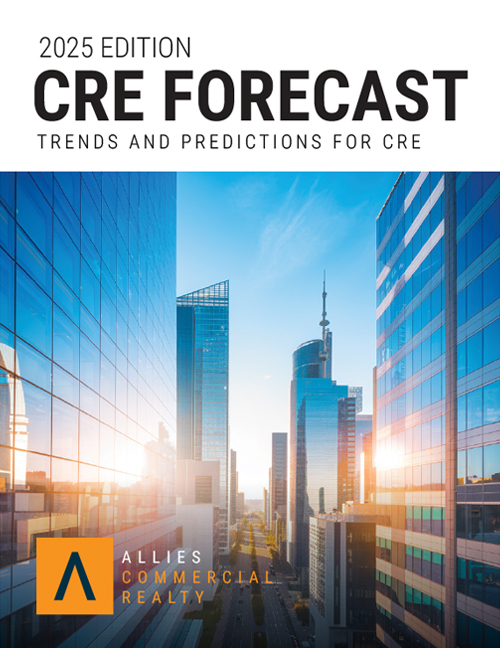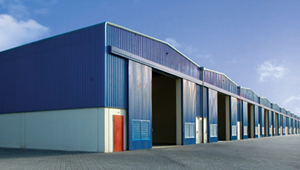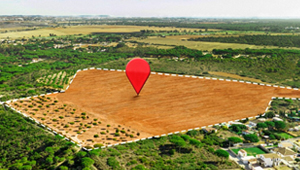Top CRE Trends To Watch In 2025

In the wake of technological advancements, shifting economic policies, evolving tenant needs and rising environmental concerns, 2025 promises a uniquely transformative year for the commercial real estate market. The Federal Reserve’s rate cut’s in September and November have reignited optimism among investors, fueling expectations for renewed growth in investment activity. At the same time, the recent election outcome introduces new possibilities for policy changes likely to impact CRE, from potential deregulation to tax incentives aimed at stimulating growth. While these shifting policies may bring opportunities to drive investment, stakeholders are carefully considering how these shifts might impact urban planning, development priorities, and the growing focus on sustainable building practices. With the increase in natural disasters such as hurricanes, extreme heat, and severe wildfires, sustainability has become a major concern. Different sustainability trends like green building standards and certification, climate resilient interior design and materials, on-site renewable energy generation etc. will be prioritized. These factors, along with emerging trends in technology, tenant demands and expectations, and evolving business needs, make the CRE landscape one to watch closely in 2025. In this article, we will explore the top trends poised to shape the market in the coming year and what they could mean for investors, developers, and tenants alike.
Adapt, invest, and grow—let’s shape your CRE strategy together.
Schedule a Discovery CallKey Commercial Real Estate Trends to Watch
To gain a competitive edge and make well-informed decisions, staying updated on the latest industry trends is essential. By doing so, industry players can anticipate tenant demands more effectively, boost property values, and position their portfolios for lasting resilience and relevance in an evolving market. Below, we explore key trends poised to reshape the commercial real estate landscape.
Path to Stabilization and Economic Recovery
Looking toward 2025, the commercial real estate market is showing promising signs of stabilization, recovering from the volatility of the pandemic and elevated interest rates. This renewed stability is creating a more optimistic outlook for the industry, paving the way for steadier growth and enhanced investment prospects. On November 7, 2024, the Federal Reserve implemented its second interest rate cut of the year, lowering rates by an additional 0.25 percentage points, bringing the cumulative reduction to 0.75 percentage points. These rate cuts can lead to improved capital availability, boosted development activity, increased transaction volume and more favorable property prices. According to a recent Deloitte survey, more than 68% of respondents anticipate improvements in key CRE fundamentals in 2025, spanning capital costs, property prices, transaction volume, leasing activity, rental growth, and vacancy levels. As market fundamentals shift toward greater resilience, stakeholders are hopeful that 2025 will bring renewed stability, economic recovery, and substantial growth opportunities.
Regulatory Reform and Policy Changes
With the new Trump administration in place, a range of policy shifts are expected to significantly shape the commercial real estate industry in 2025. Proposed initiatives like tax incentives, regulatory rollbacks, and zoning reforms could open new growth channels. For instance, extending the 2017 Tax Cuts and Jobs Act (TCJA) would continue to benefit 1031 exchanges, allowing tax deferrals that encourage reinvestment into commercial real estate properties. Additionally, the administration’s deregulatory approach aims to streamline zoning and permitting processes, reducing development costs and delays and spurring faster project approvals. Expanding federal land access for development, along with simplified zoning requirements, is intended to address housing shortages in high-demand areas, enabling more mixed-use developments that combine residential, retail, and office spaces. The TCJA’s Opportunity Zones program also remains a cornerstone of the plan, incentivizing investments in underserved areas to drive local revitalization. Further supporting CRE, infrastructure investments under the IIJA (Infrastructure Investment and Jobs Act) are expected to maintain momentum, benefiting investors across sectors. Lastly, while interest rate changes fall under the Federal Reserve’s purview, the Trump administration has expressed a preference for lower rates, which could reduce financing costs and stimulate more commercial real estate investment. Overall, the anticipated policy shifts hold great potential to catalyze commercial real estate growth in 2025, creating an environment primed for investment, development, and growth.
Increase in Sustainable Development
Sustainability practices are set to play a crucial role in shaping the industry, with 51% of respondents from major global economies reporting that environmental sustainability matters more to them now than it did just a year ago, according to an IBM survey. The growing focus on sustainability is driven by concerning statistics: buildings are responsible for about 39% of global greenhouse gas emissions, as reported by the United Nations Environment Programme (UNEP). Furthermore, the Intergovernmental Panel on Climate Change (IPCC) highlights that the real estate and construction sector accounts for 36% of global energy consumption and nearly 40% of energy-related CO2 emissions. To help reduce carbon emissions and promote sustainability, governments and authorities at all levels will enact strict regulations. Executive Order 14008, for instance, plans to conserve 30% of US lands and waters by 2030, and Executive Order 14030 imposes strict emission requirements for federal buildings and vehicles. The push toward mandatory Environmental, Social, and Governance (ESG) reporting is gaining momentum, particularly with the introduction of regulations like New York City’s Local Law 97, which enforces emission restrictions on buildings exceeding 25,000 SF. To meet these ESG standards, developers, investors, and occupiers are turning to Green certifications:
LEED (Leadership in Energy and Environmental Design): Assesses buildings for energy efficiency, water conservation, sustainable site development, material selection, and quality of indoor environment.
BREEAM (Building Research Establishment Environmental Assessment Method): Assesses environmental impact across energy, health, and pollution metrics.
National Green Building Standard (NGBS): Covers everything from energy efficiency to water conservation and indoor air quality.
WELL Building Standard: Centers on the health and wellness of building occupants.
Renewable energy adoption is also expanding as government incentives encourage sustainable practices. Through the Inflation Reduction Act (IRA), developers can access tax benefits for solar panels or energy-efficient infrastructures. By 2025, the commercial real estate sector is anticipated to embrace advanced building management systems, AI-powered analytics, and contactless solutions, all of which will help optimize energy efficiency, curb waste, and lower operating costs, contributing to reduced carbon footprints.
Hybrid Work and Office Space Redesign
As businesses emerge from the pandemic, the demand for flexible workspaces remains a critical trend reshaping the commercial real estate landscape. With 80% of employees showing a preference for hybrid or remote work, businesses are choosing scalable workspace solutions to adapt to fluctuating needs. Data indicates that 62% of global employees have opted for hybrid schedules, while 16% work fully remotely, reinforcing the sustained interest in flexibility. As reported by Flex Index in Q3 2024, flexible work arrangements are now offered by 90% of U.S.-based companies that started after 2011.
As more companies embrace hybrid and remote work, demand for flexible office and co-working spaces is set to rise. This trend includes a preference for multi-use spaces that combine office, recreational, and living areas, catering to the changing needs of employees seeking balanced, adaptable work environments. This evolution in workspace design reflects a shift toward fostering productivity and a balanced lifestyle within a single dynamic setting. Flexible, shorter-term leases are gaining appeal among tenants, enabling them to pivot with changing demands and avoid being locked into long-term agreements. The shift to hybrid work has made technology indispensable, with digital tools such as video conferencing and project management software ensuring consistent communication and workflow across remote and in-office teams.
The growing trend of hybrid and flexible work has led companies to reimagine office spaces with a focus on multi-purpose, adaptable designs that balance productivity and well-being. Looking ahead, incorporating flexibility, advanced collaborative technologies, and adaptable spaces will be crucial for enhancing tenant satisfaction and ensuring sustained value in property portfolios.
Urban Revitalization and Mixed-Use Developments
As the demand for urban living grows, urban revitalization is playing a pivotal role in transforming once-declining areas and improving their economic, social, and physical conditions. The advancement of transportation systems and infrastructure is driving greater urban density, with the World Health Organization projecting that 70% of the global population will live in cities by 2050. This shift presents vast opportunities for commercial real estate, particularly in revitalized urban hubs poised for growth.
Mixed-use developments are at the frontline leading the charge in urban transformation by integrating residential units with retail, office, and recreational spaces. Designed to meet the growing preference for convenience and a balanced lifestyle, these spaces enable residents to live, work, and engage in recreational activities within a single location, reducing dependence on lengthy commutes. The appeal of mixed-use developments is expected to grow, particularly for Real Estate Investment Trusts (REITs), as they offer diversified income streams, higher occupancy rates, and the potential for premium rental prices. According to a report, rents in mixed-use properties can be up to 25% higher than in traditional single-use spaces. In many cities, these mixed-use developments are central to urban revitalization efforts, with public-private partnerships (PPPs) becoming a key strategy for creating spaces that benefit both communities and investors. Looking to the future, mixed-use developments are expected to leverage advanced technologies such as augmented and virtual reality to enhance planning and design, while placing greater emphasis on climate resilience and sustainability, ensuring these spaces evolve to meet both environmental and societal needs.
Tech Integration and AI
With 61% of firms already utilizing technology solutions and the PropTech market expected to grow at a CAGR of 15.8% from 2022 to 2030, innovation is reshaping the industry. A staggering 81% of industry leaders are expected to prioritize data and technology investments in 2025, signaling a shift toward innovation-driven growth. Virtual and augmented reality tools are revolutionizing property viewings, while the Internet of Things (IoT) provides real-time data for predictive maintenance and improved tenant services. AI takes center stage in this transformation, offering enhanced tenant experiences, streamlined operations, and data-backed decision-making that boost property values and occupancy rates. Additionally, robotics and AI-driven automation are set to redefine building maintenance and security, enabling property managers to focus on complex, high-value tasks. With these advancements, the CRE sector is embracing a future where technology integration drives operational efficiency, enables smarter decision-making, and secures a competitive edge in an ever-evolving market.
Sector Specific Trends
With the Commercial Real Estate market gaining momentum, investors are prioritizing the need to respond to changing consumer demands and preferences. In the sections that follow, we will examine the sector-specific trends expected to emerge in the coming year, shedding light on the developments that could redefine the CRE landscape in 2025.
Retail Resilience: After experiencing a downturn during the pandemic, the retail sector is showing promising signs of recovery. Demand for physical retail spaces is rising, driven in part by limited supply due to reduced construction activity in recent years. Looking ahead to 2025, retail spaces are expected to transform into hubs for social interaction and immersive brand experiences, shifting away from purely transactional purposes.
Escalating Demand for Data Centers: As cloud computing becomes more integral to business operations and AI technologies continue to expand, the demand for strong digital infrastructure is on the rise. The increase in global data consumption is prompting the need for larger data center facilities to effectively manage and store this information. With technology evolving at breakneck speed, data centers are set to remain a lucrative asset class in the coming year.
Industrial Expansion: The industrial sector’s growth trajectory continues as companies adapt to rising e-commerce volumes and supply chain demands. Facilities such as smart warehouses and automated distribution centers, particularly those located near urban centers and key transportation hubs, are in high demand. With advancements in technology and sustainability, the industrial sector is poised for substantial growth by 2025, attracting more investment and strengthening its position in the CRE landscape.
Emphasis on Tenant Experience and Well-being
As the market becomes increasingly competitive, stakeholders are recognizing the importance of creating positive, supportive environments to attract and retain tenants. By 2025, tenant experience and well-being are set to become key pillars of successful CRE strategies. Research reveals that tenants highly value amenities that foster both physical and mental health, with a growing demand for spaces that encourage wellness and community engagement. Properties that offer features such as natural lighting, green spaces, and dedicated wellness facilities not only enhance their appeal but also boost tenant retention rates. Additionally, the integration of advanced technologies—such as smart building systems and tenant-focused apps for communication and service management—ensures a seamless, personalized experience, making these properties even more desirable in a competitive market.
Growth in Secondary and Sun Belt Markets
The secondary and Sun Belt markets are set to experience significant growth, driven by demographic shifts, economic opportunities, and changing workplace dynamics.
Secondary Markets: The migration of individuals and businesses from high-cost coastal cities to more affordable secondary markets has fueled demand for commercial and residential properties. Investors are drawn to these markets for their lower entry costs, strong economic potential, and increasing development opportunities.
Sun Belt Markets: Favorable climate, lower living costs, and pro-business environments make the Sun Belt a magnet for migration. Sun belt regions, for instance, Phoenix and Austin are experiencing unprecedented population growth with a net migration increase of over 100,000 residents annually in some areas. This influx is fueling demand for commercial real estate developments, from housing to office and retail spaces.
With their expanding opportunities and shifting dynamics, secondary and Sun Belt markets are positioned to be game-changers in commercial real estate financing in 2025, attracting a wide range of stakeholders.
Conclusion
As commercial real estate companies enter 2025, they face a landscape ripe with opportunity, fueled by transformative trends such as sustainability, technological advancements, and the rise of secondary and Sun Belt markets. These trends promise significant growth, from the increasing demand for eco-friendly buildings to the integration of smart technologies that enhance tenant experience. With favorable economic shifts and regulatory changes, stakeholders are positioned to benefit from a more stable and dynamic market. However, some challenges require careful consideration. Economic policies, including the administration’s tariffs on imported building equipment, may increase construction costs. At the same time, demographic changes and evolving consumer preferences are driving the need for more flexible, sustainable spaces. Supply chain disruptions could delay construction, while technological advances may reshape traditional property management practices. Furthermore, climate-related risks such as rising insurance premiums could impact profitability. Despite these challenges, the immediate future of CRE remains bright. By embracing innovation, adapting to the evolving market, and capitalizing on new opportunities, stakeholders can navigate these obstacles and position themselves for success in this rapidly changing landscape.
Topic: CRE Market Trends
Future-proof your investments—gain expert insights now!
Talk to a Broker
About the Author - Adam Stephenson, CCIM, SIOR
With over a decade of experience in commercial real estate, Adam is a trusted advocate for privately held organizations, specializing in industrial properties across Central Indiana. Adam brings a wealth of expertise in tenant representation, lease negotiations, and strategic asset acquisitions. A graduate of Indiana University – Indianapolis with a degree in Business Management, he further distinguished himself by earning the prestigious CCIM & SIOR designations. His deep industry knowledge, client-focused approach, and commitment to delivering tailored solutions make his insights invaluable.
Download Our Free Resource:
2025 Edition - CRE Forecast:
Trends And Predictions For CRE.

You might also enjoy reading:
Cookies improve your browsing experience, deliver tailored ads or content, and assess our website traffic. If you click 'Accept All’ you are giving your consent for us to utilize cookies. Check our cookies policy here.
Adding {{itemName}} to cart
Added {{itemName}} to cart





















